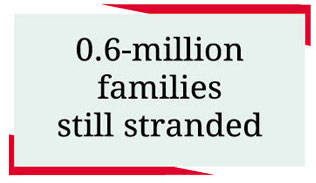
Flood victims’ woes multiply amid spread of diarrhoea
Floods take 67 lives in south-east so far
FE REPORT | Tuesday, 3 September 2024
 The deluge in the south-eastern regions have so far claimed 67 lives in eleven flood-stricken districts, according to a latest report released by disaster management and relief ministry.
The deluge in the south-eastern regions have so far claimed 67 lives in eleven flood-stricken districts, according to a latest report released by disaster management and relief ministry.
Of the diseased, 26 died in Feni, 17 in Cumilla, 11 in Noakhali, six in Chattogram, three in Cox's Bazar and one each in Brahmanbaria, Khagrachhari, Moulvibazar and Laxmipur districts.
Of the latest fatalities of eight persons, three were reported in Feni and Cumilla each and two were in Noakhali district.
Besides, more than 0.6-million families have been stranded in 68 upazilas of 11 flood-hit districts - Feni, Cumilla, Chattogram, Khagrachhari, Noakhali, Moulvibazar, Habiganj, Brahmanbaria, Sylhet, Laxmipur and Cox's Bazar.
Again, more than 6.0-million people have been affected in 504 municipalities or unions of these districts.
According to the ministry, the flood situation in Brahmanbaria, Chattogram, Habiganj, Sylhet, Cox's Bazar and Khagrachhari is stable, while Moulvibazar Cumilla, Feni, Noakhali and Laxmipur are witnessing improvement.
Meanwhile, more than 0.3-million people are in 3,615 flood shelter centres.
At least 32,830 domestic animals are also kept in those centres, reveals data available with the ministry. A total of 472 medical teams are providing health services in flood-affected areas.
The ministry has provided Tk 45.2 million in flooded districts along with 20,650 tonnes of rice, 15,000 packs of dry food or others, and baby food and fodder worth Tk 7.0 million.
As the flood situation has improved in many areas, a number of families have started to return to their respective homes.
Meanwhile, the rescue and relief operation is being continued with the involvement of the Army, Navy, Coast Guard, Fire Service, Anti-Discrimination Student Movement and hundreds of volunteer organisation.
The army has distributed 0.345-million packs contain dry food, water, clothes and other items along with 22,100 packets of cooked food. It also rescued an estimated 46,000 people. Again, 42,113 were given necessary treatment.
Meanwhile, student volunteers have provided 0.174-million packets containing dry food, clothes and water through the Department of Disaster Management.
However, the number of patients suffering from diarrhoea has been rising alarmingly in flood-affected districts, where water levels have begun to recede amid a shortage of fresh water.
In Feni, more than 200 patients have been admitted to the Sadar General Hospital in the last two days, sources reported.
Due to bed shortages in the 250-bed hospital, many patients are being treated on the hospital floor. At least 50 patients are receiving treatment in the open area outside the diarrhoea ward.
The hospital has been overwhelmed with diarrhoea cases since the floods began. The influx of patients has forced many to take shelter outside the hospital, with some spilling onto wards and balconies.
There were 173 cases as of Monday morning, including 140 women and kids. The total number reached 568, putting a severe strain on hospital resources.
Hospital supervisor Abul Khair Miyazi said, "In the morning, there were 173 patients. However, by noon, the number increased to over 200. We have sought additional medicines, which are expected to arrive soon."
On Monday afternoon, several diarrhoea cases were seen spreading mats under trees outside the hospital, where they were being administered saline.
Hospital sources said patients were arriving from six different upazilas in Feni, with the influx starting on August 25.
However, the situation has worsened over the past two days.
A nurse said the shortage of medical staff further disrupted medical services in the 18-bed diarrhoea ward.
Mr Miyazi spoke about shortages of doctors, nurses and essential medicines. Even the hospital has been without a medicine expert for three months.
"We don't have enough medical officers, and there is also a shortage of nurses. Additionally, some medicines were lost due to flooding, forcing patients to buy certain medications from outside."
Meanwhile, water levels of Brahmaputra-Jamuna rivers are currently decreasing, with the Brahmaputra expected to remain stable over the next 24 hours, while Jamuna's water level may continue to drop.
The Ganges-Padma rivers are also witnessing a decrease in water levels, which are projected to remain stable in the next 48 hours.
In northern Rangpur division, Teesta, Dharla and Dudhkumar rivers are experiencing an overall rise in water levels, but they are expected to flow normally and remain below the danger level for the next two days.
In north-east, the water level of the Kushiyara is increasing, whereas the Surma is decreasing, a trend that may persist for the next 24 hours.
In south-east, especially in Chittagong division, the Sangu's water level is rising, while other major rivers in the region are decreasing generally.
Meteorological forecasts suggest no significant rainfall in south-eastern and adjacent uplands for next 48 hours, potentially contributing to a further reduction in water levels of major rivers like Muhuri, Gomti, Sangu and Matamuhuri.
tonmoy.wardad@gmail.com